6 Highest Quality And 5 Lowest Quality Instant Ramen Brands
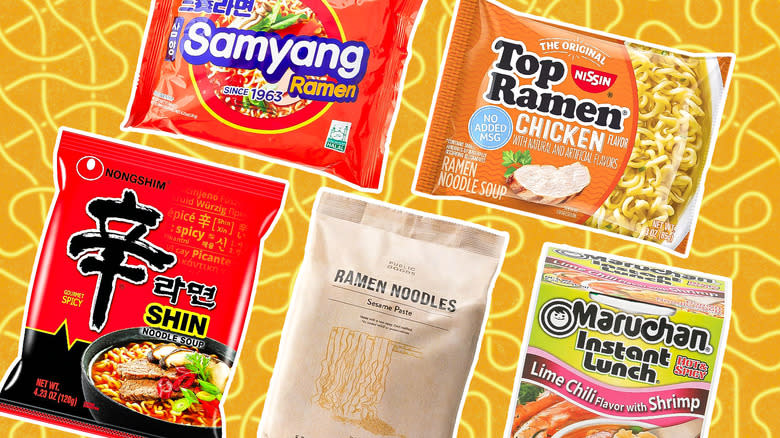
Instant ramen isn't just lore from your college days, but a staple in many diets around the world today. Primarily consisting of a dried noodle cake, along with a pack of seasoning or a sauce packet, this quick-fix meal option is meant to satisfy cravings, fill you up, and deliver maximum flavor, all in under a few minutes. What you need to know about ramen (and not necessarily ramyeon, its Korean counterpart) to judge it best is that this dish originated in China, building on flavors from a rich meat broth, hand-cut noodles, and fresh vegetables. The dish only made its way to Japan in the 1900s where it rose to wider fame after World War II.
Despite its much-loved status today, instant ramen isn't inherently a healthy meal option, especially when regularly consumed, as it's typically loaded with sodium, lacks essential nutrients like protein and fiber, and may have controversial additives. However, there are definitely higher-quality options that include more protein and vegetables, less salt, and fewer processed ingredients.
In our search for the highest quality ramens to incorporate in our diets (and the lowest quality ones to leave behind), we examined nutritional labels, flavors, online reviews, and ingredients. From restaurant-quality ramens like Momofuku to the spice extraordinaire Samyang, look for your favorite ramen below and see if it made the cut.
Read more: Frozen Pizzas, Ranked From Worst To Best
High: MìLà Ramen

If you're tired of the old cup noodles, try upgrading to a high-quality product like MìLà ramen. Famous for its frozen soup dumplings, the brand was started by second generation Chinese Americans who created products that reflect the authentic flavors of their family's culinary heritage. The ramen is a touch up from your regular ones, taking 8-10 minutes to prepare and featuring a sauce packet of flavors like Spicy Dan Dan, Caramelized Scallion Oil, and Sweet & Savory. The sauces are added to bouncy wheat noodles made from the traditional sun-drying method from Guanmiao, Taiwan, then flash-frozen raw so you can cook the noodles fresh.
With spices like Sichuan peppercorns, chili oil, Chinese mustard greens, and toppings like crunchy peanuts, this ramen redefines what a packaged noodle can offer. Consumers laud the noodles for its restaurant-quality flavors and lack of additive-laced seasoning packs, saying that it delivers a filling and delicious ramen each time. The brand became so loved for its products that actor Simu Liu became its Chief Content Officer and it collaborated with internet character Uncle Roger to launch a spicy noodle kit. These noodles are on the pricier end of instant noodles on this list, at $38.99 for a pack of 4, falling at $9.74 per pack. For the savory umami flavor in the Scallion noodles and tingly spice achieved from its blend of 27 spices in the Dan Dan noodle, we'd say the price is worth it.
High: Momofuku
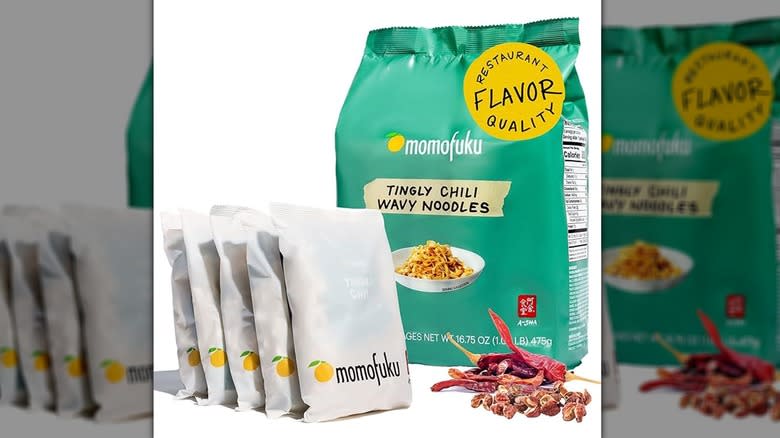
Bringing the flavors of New York's Momofuku Noodle Bar to your bowl is the brand's packaged ramen. If you've never slurped the restaurant's mouthwatering noodles, developed by celebrity chef David Chang, getting the packaged version is about as close as it gets. The ramen is made in collaboration with A-sha, a Taiwanese noodle company. A-sha's 18-hour air-dried noodle technique results in chewy noodles with more protein and fewer calories compared to many other noodle brands. Getting the ramen packs will also likely be much cheaper than eating in-person at the noodle bar, as a 5-pack of noodles retails at $13 on the website.
It currently comes in five variations of spicy, sweet, and savory, each with a sauce packet that builds on ingredients like Sichuan spices, Korean chili paste, soy sauce, sesame oil, and fresh scallions to deliver maximum flavor. America's Test Kitchen rated its Tingly Chili flavor as the best instant noodle of the lot, owing to its chewy texture and spicy kick from the sauce, which adheres well to the noodles. The noodles also pair well with flavors from carbonara, kimchi, and pad Thai by adding contrasting ingredients.
However, a look at the nutritional label reveals sodium levels that are relatively high, from 990 to 1,400 milligrams per serving. These likely come from the ramen's dose of soy sauce, which is naturally salty, but the brand recommends halving the sauce pack or cutting it with water if you're watching your salt intake.
High: Prima Taste Laksa La Mian
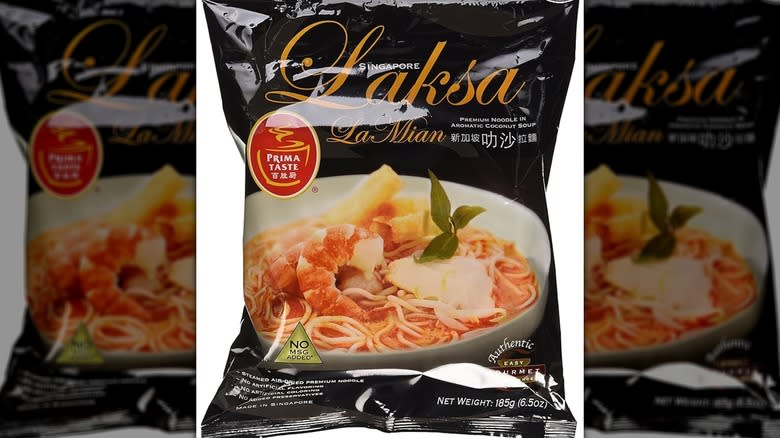
Laksa has been around nearly all of Southeast Asia, combining ingredients from different regions into an aromatic and flavorful broth served with noodles. The Prima Taste brand brings its Singaporean version of these noodles to your table in a packaged ramen that contains a pack of laksa paste, made from the authentic laksa ingredients like chili paste, galangal, lemongrass, shrimp paste, dried shrimp, and turmeric. There's also a laksa premix utilizing coconut milk powder that makes the ramen incredibly creamy. Combining the two creates a rich broth with notes of ginger from the galangal and pungent aroma from the shrimp.
The la mian or noodles in this ramen are air-dried, lending them a firm and chewy texture. Consumers and reviewers alike love the combination of fishy laksa paste with coconut milk powder, plus a squeeze of fresh lemon juice for an added brightness. For $11.45 for a four-pack on the brand's website (at the time of writing), these noodles fall at $2.86 per pack and in the middle range of prices in this list. Considering the distinct flavor profile of this ramen compared to your regular chicken noodle, we'd say these are worth the cost.
Low: Samyang Ramen
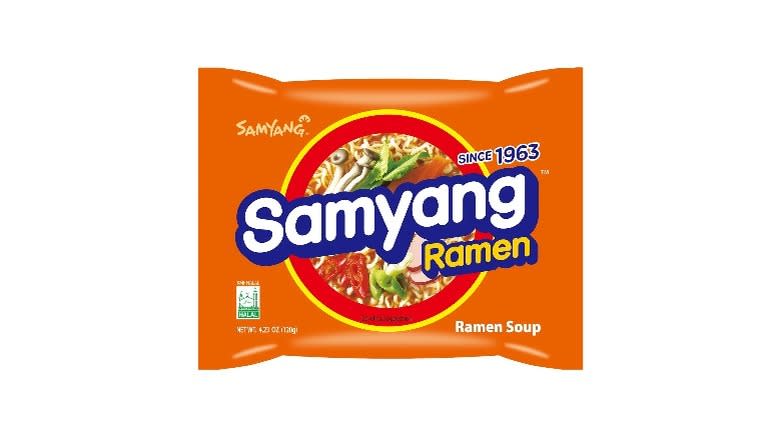
Many people were surely introduced to the flavors of Korean ramen with Samyang, featuring a spicy gochujang and gochugaru sauce base. Its Buldak line has inspired viral trends like the Fire Noodle Challenge owing to its super hot flavors. However, Samyang's products beg the question of whether spice alone should carry a ramen's flavor. Even its original ramen has four peppers in its ingredients including cayenne, chili, black, and red peppers, which pack an intense heat, and few natural ingredients. With thick-cut noodles that absorb sauce well, they're easy to slurp and a darling for ramen eaters tired of broth-heavy noodles.
Taste wise, it's no secret that Samyang is a consumer favorite (there's just something about that eye-popping spice). However, in terms of quality, it is much like many other mass-produced ramen brands. It contains 1,930 milligrams of sodium per pack, which is just a few hundred grams short of your daily recommended maximum (set at 2,300 milligrams a day by the FDA, but the American Heart Association argues that a max of 1,500 milligrams is a better goal). Other ingredients that make it a low-quality meal option include 5 grams of added sugar, which is unusual considering there's little detectable sweetness in this ramen's flavor. Price-wise, this ramen is more costly than many other mainstream brands like Nissin's Top Ramen, at $13.27 for a 5-pack (about $2.65 per pack) on Walmart at the time of writing.
High: Chef Woo Ramen
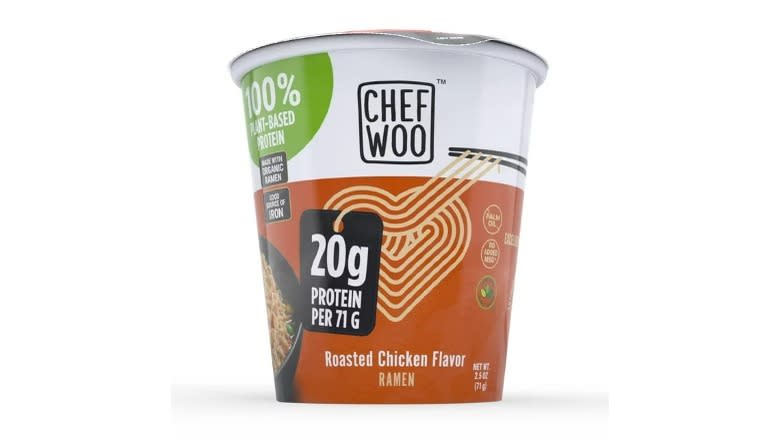
After consuming ramens flavored mostly with chicken, beef, or seafood, a plant-based ramen might not initially sound as appealing. However, you'll reconsider after trying Chef Woo ramen, which brings a vegetarian touch to your favorite quick fix meal, featuring plant-based proteins. Available in chicken, beef, Thai lemon, and sweet chili flavors, each ramen relies heavily on vegetables such as dried carrots, onions, bell peppers, peas, and corn, which gives the ramen ample flavor and texture. Consumers also love the broth, which gets an umami flavor boost from torula yeast. The ramen also uses autolyzed yeast and yeast extract for its protein content; it's also a good source of B vitamins but this ramen is high in sodium -- around 1,120 milligrams for a single serving -- so it's important to watch your intake.
Beyond that, many argue that noodle quality can make or break your ramen, and that's where the Chef Woo variety passes the vibe check. Customers like that the noodles are firm and don't become soggy or slippery like other brands, even after it's been sitting for a while in the broth. The texture is almost certainly due to the high-protein noodles made from organic wheat flour. The noodles typically retail for $32 for a 12-pack (about $2.66 a cup), making them an affordable and relatively healthy choice for cup noodles.
Low: Nissin Top Ramen
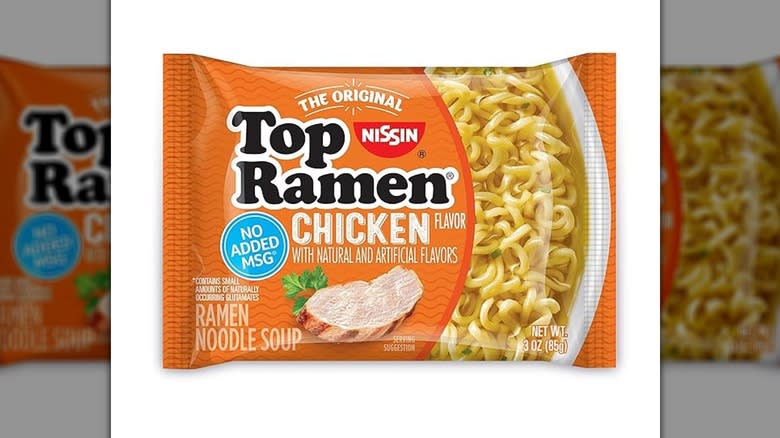
If you were a college student after 1970, chances are your diet consisted heavily of Top Ramen. Although abundant in flavors, the often orange-hued packs were most commonly stacked in dorms, as the reliable flavors, under three-minute cook time, and thin noodles were an easy and palatable meal. Graduating (from college and this ramen) was probably like ending a fever dream as more authentic-tasting and flavorful ramens entered your diet.
Nutritionally, these packs often include a paragraph of hard-to-pronounce ingredients, relying on preservatives to maintain shelf life, and even potentially harmful ones like TBHQ which has been potentially linked to neurological issues via animal studies, though it's also considered safe in small doses (via Healthline).
One pack also typically contains 1,530 milligrams of sodium and 7 grams of saturated fat, which can increase your cholesterol level and risk of heart disease. All these factors aside, Top Ramen probably isn't the worst instant ramen out there, but as consumers complain about bland flavor, mostly soupy consistency, and cardboard-like noodles here, these aren't anything to write home about. The only saving grace of this ramen is its low price point. Currently, you can pay $6.47 for a 5-pack of the chicken flavor on Amazon, which comes out to about $1.30 per pack.
High: Public Goods Ramen
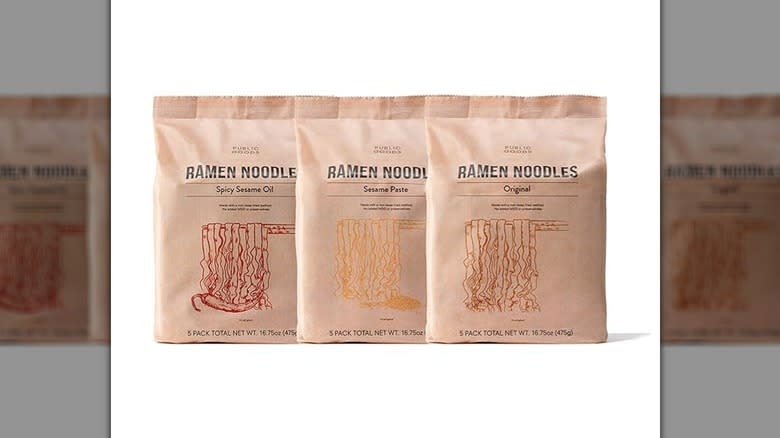
If there was a contest for instant ramens with the most natural list of ingredients, the winner could well be Public Goods. Its ramen is the simplest and most wholesome we came across, bearing wheat flour noodles made from a technique that eliminates deep-frying to result in a lighter noodle. The brand also promotes a healthier take on the original ramen by making its version broth-less, with only a packet of soy sauce and sesame oil for seasoning in the original flavor. It also has a Spicy Sesame flavor that comes with the addition of chili oil, and a Sesame Paste flavor.
Consumers laud the ramen for its simplicity, saying it's perfect for a hot and delicious meal for those in a time crunch, while others use it as a blank canvas to pair with their favorite sauces, proteins, and sides. The ramen is available on the brand website for $10.95 for 5 servings, falling at $2.19 per serving. The only potentially questionable value we found that this ramen provides is its sodium level, which ranges from 1,150 to 1,560 milligrams per serving, more than half of the FDA's recommended daily sodium maximum of 2,300 milligrams.
Low: NongShim Shin Ramen
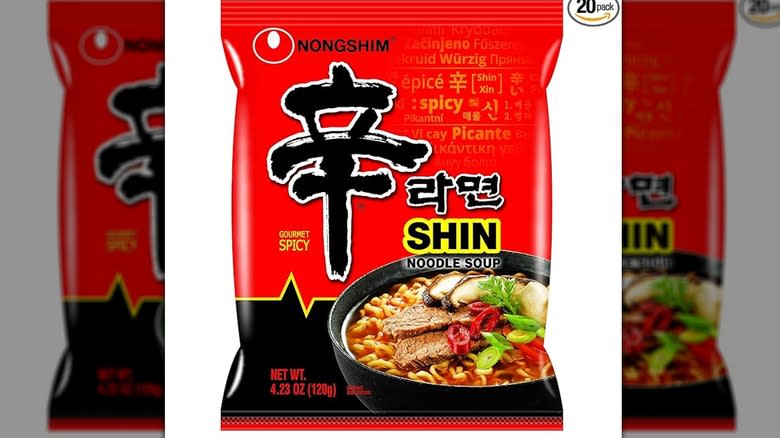
With Korean brands taking center stage in the instant ramen race, NongShim is a front runner. Its Shin Ramen is an iconic line with flavors like the Shin Black that are a particular favorite of both chefs and everyday customers. However, it's the original flavor that has most fans entranced, with its spicy beef broth made from beef bone extract, dried shiitake mushrooms, and smooth, thin noodles.
It's easy to get lost in the oil-flecked surface of the instant soup while slurping these noodles by the mouthful. But don't forget to inspect what's really in the pack. The ingredients listed here read like an essay on what shouldn't go in your ramen, while also noting that beef flavors make up less than 2% of ingredients. The rest are artificial flavors, preservatives, and processed flours and proteins. Of course, it's generally not going to be damaging to your health if you consume this only occasionally. The nutrients to look out for are the 1,960 milligrams of sodium and 8 grams of saturated fat, which should be especially limited if you're watching your intake of these. Price wise, these are a bang for your buck, as a 4-pack costs $4.66 on Walmart (at the time of writing), and each 120 gram pack falls at about $1.16.
High: Lotus Foods Millet And Brown Rice Ramen
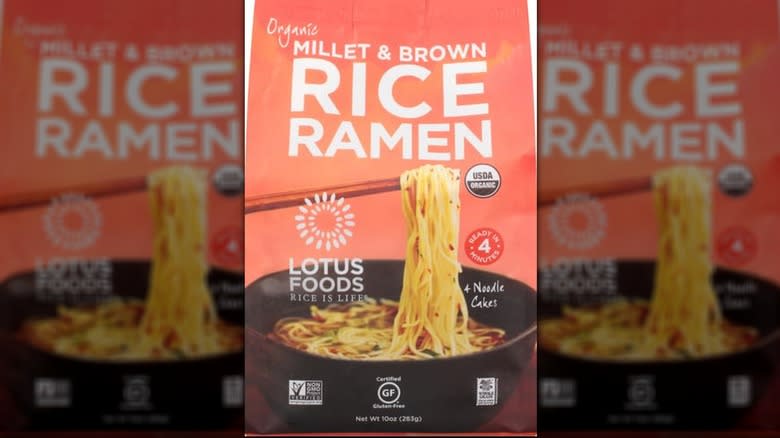
If the seasoning packet is what defines ramen for you, think again, as the Lotus Foods ramen is a unique product featuring plain noodles made from organic brown rice flour and millet flour. What may sound like bland ramen is actually a blank canvas for creation, as the nutty flavor of the noodles is perfect for making tasty additions to your ramen by incorporating ingredients like cheese, bacon, or sausages. The brand's Japanese-style noodles are a healthier take on wheat noodles, cook in just four minutes, and are a good source of protein and fiber. The ramen also comes in a Red Miso Soup flavor with spicy dried wakame seaweed and miso broth.
These noodles are also a great gluten-free option for many hungry people, with customer praise singling this out as an alternative to regular ramen. Others love the texture of the noodles, which remains firm and has a great mouthfeel even after spending extra time in the broth. These are also on the cheaper end of ramen on this list, retailing on the brand's site at $6.99 for a pack of four ramen cakes.
Low: Maruchan Ramen
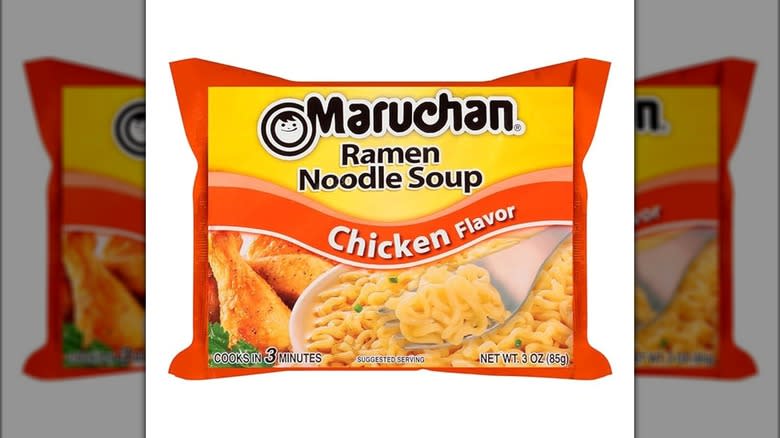
The smiley-faced figure with bangs on the Maruchan logo is no stranger to many people, who enjoyed it as an after-school snack and college meal. This Japanese brand became a household staple in the U.S. in the '80s, with its yellow-gold packaging and familiar comfort flavors like chicken and beef. For many, this was simply the OG ramen. Now, trashing all your childhood memories of instant ramen wasn't on our agenda here, but can you blame us for the subpar quality of most ramen brands? At least this is the case for Maruchan, whose thin noodles are basically a carb cake made from enriched flours and preserved with TBHQ.
Flavors like its creamy chicken rely on a powdered cream substitute made from palm oil, the production of which has been sometimes been deemed harmful to the environment (though palm oil's reputation has been recovering somewhat in recent years) and corn syrup to carry flavor. Other flavors like the classic chicken, pork, and shrimp aren't that appetizing either, and were at the bottom of a Food Republic ranking of every Maruchan flavor from worst to best. On the price front, a 12-pack of chicken ramen costs $8.94 on Walmart (at the time of writing), falling at roughly $0.74 per pack, making it the cheapest ramen on this list.
Low: Myojo Ramen
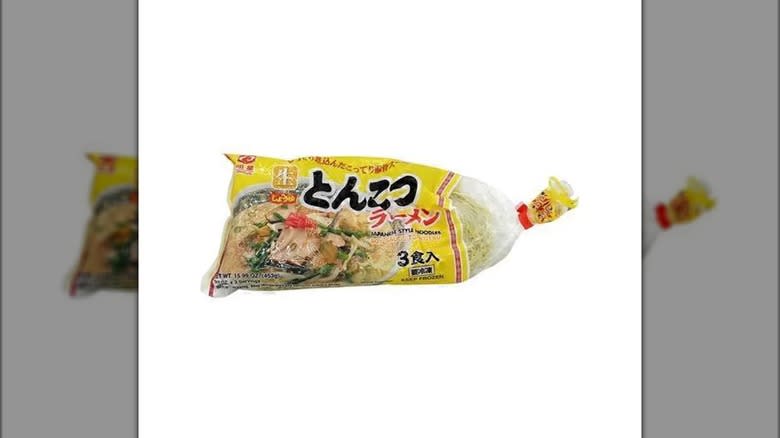
One of the most popular brands of Japanese ramen, Myojo is known for signature flavors like tonkotsu, shoyu, and miso. The brand has been marketing its ramen, udon, yakisoba, and gyoza wrappers to U.S. restaurants since 1991. Available in both freshly frozen and instant ramen packs, the Signature Tonkotsu flavor combines pork extract with Japanese shoyu sauce for an umami-rich broth.
However, the quality falls prey to the same shortfalls that other instant ramen brands face, depending too much on salt to deliver its taste. The Signature Tonkotsu flavor has 3,020 milligrams of sodium per serving, which is 700 milligrams above the FDA's recommended maximum! As for the chewy noodles, they're your standard instant ramen noodle cake, but with food dyes like Yellow 5 , the consumption of which has been linked to behavior disturbances in children, though research is ongoing (via Healthline).
Flavor wise, these noodles are a great option for packaged ramen, as they're easy to prepare and deliver a superior flavor. However, the ingredients that make this flavor are a potentially unhealthy bunch, including hydrolyzed proteins and modified food starches, which are processed ingredients with little nutritional value, some form of sugar every few ingredients, and all that sodium. Put plainly, these noodles fall short of a wholesome ramen, and can be easily swapped for any of the high-quality options of this list without compromising on flavor. A 16-ounce pack of three servings retails at $4.99.
Methodology
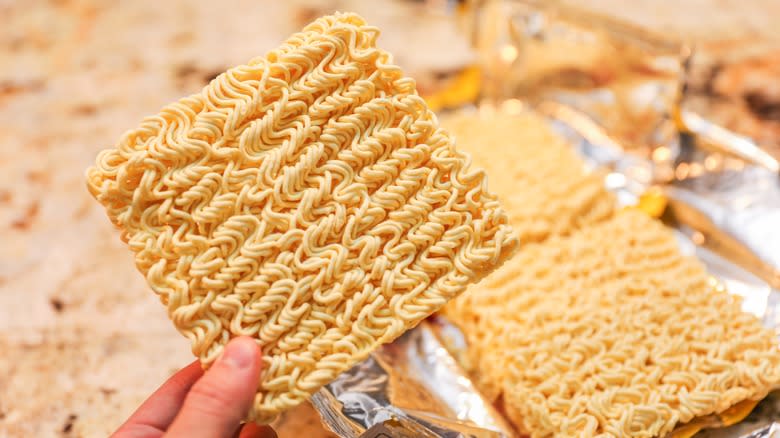
Rating the highest and lowest quality instant ramen brands came down to a few factors, including taste, ingredients, and nutritional value. We singled out ramens with fewer ingredients overall and fewer artificial add-ins, as well as high-quality flavor as reported by reviewers. Those with processed ingredients, preservatives, and high quantities of sodium and sugar were rated as low quality. We also argue that noodles made from whole grain flours like brown rice and organic wheat are a sign of higher quality ramen, as well as noodle cakes that were air-dried as opposed to deep-fried.
Most ramen brands have relatively high levels of sodium, but when these levels are due to excessive salt and flavor enhancers like MSG in abundance, it lowered the ramen's quality overall. Finally, we compared the prices of instant ramen brands and found that higher quality ramen tended to be costlier (coming in as high as $9 per pack) but also delivered flavor and texture that you may find to be similar to ramen served up by your favorite restaurant.
Static Media owns and operates Mashed and Food Republic.
Read the original article on Mashed.


